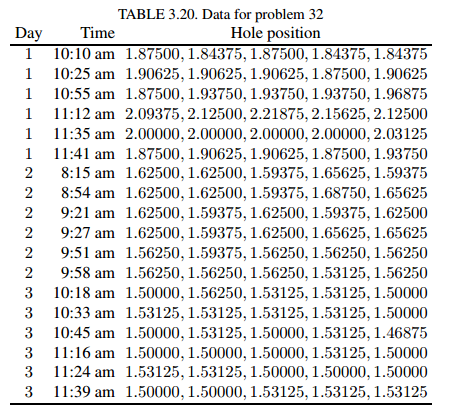Reference no: EM131550753
Question: Refer to the Plastic Packaging case in problem 32.
(a) Calculate the 18 subgroup means and 18 subgroup ranges.
(b) Use your answers from part (a), and for each day separately, make retrospective control charts for mean hole position. Give center lines, control limits, and zone limits. What do these charts suggest about process performance?
(c) Use your answers from part (a), and for each day separately, make retrospective control charts for variability of hole position.
(d) Based on your answer to (c), is variability of hole location constant within any one of the days? Why or why not?
(e) According to your charts in (c), is there a day in which a single standard deviation of hole position is plausible? Why or why not?
(f) Suppose your answer in (e) is "yes" for each day. Find estimated for the three different days treated separately. (Base your estimates on sample ranges.)
(g) Comment on how your estimates in (f) compare to the estimate in part (h) of problem 32.
Problem: Plastic Packaging. This concerns a plastic packaging case investigated by Hsiao, Linse, and McKay. Plastic bags were supposed to hold three bagels each. An ideal bag is 6.75 in wide, has a 1.5- in lip, and has a total length of 12.5 in (including the lip). The ideal hole positions are on the lip. The hole position on selected bags was measured as the distance from the bottom of the bag to the hole. Five bags were obtained at six times on each of three days. Hole position, bag width, bag length, and lip width were measured and recorded for each bag.
The data for hole position (in inches) are in Table 3.20.
(a) What is a natural subgroup in this situation?
(b) How many items are in each subgroup described in (a)? How many subgroups are there here in total?
(c) Calculate the subgroup means and subgroup ranges.
(d) Make a retrospective control chart for mean hole position. Give the center line, control limits, and zone limits using your answers from part (c).
(e) Make a retrospective control chart for variability in position using your values from (c). Give the control limits and zone limits.
(f) What is the usual name of the chart in (d)? What is the usual name of the chart in (e)?
(g) Is it important which of the charts developed in (d) and (e) is analyzed first? Why or why not?
(h) Find the estimated standard deviation of hole position based on the ranges.
